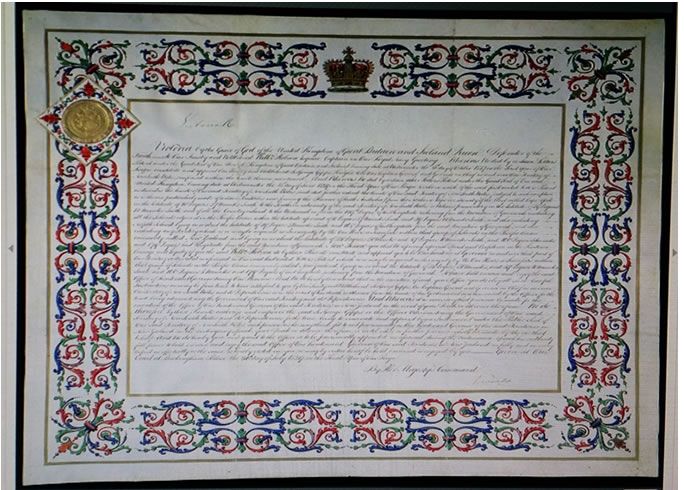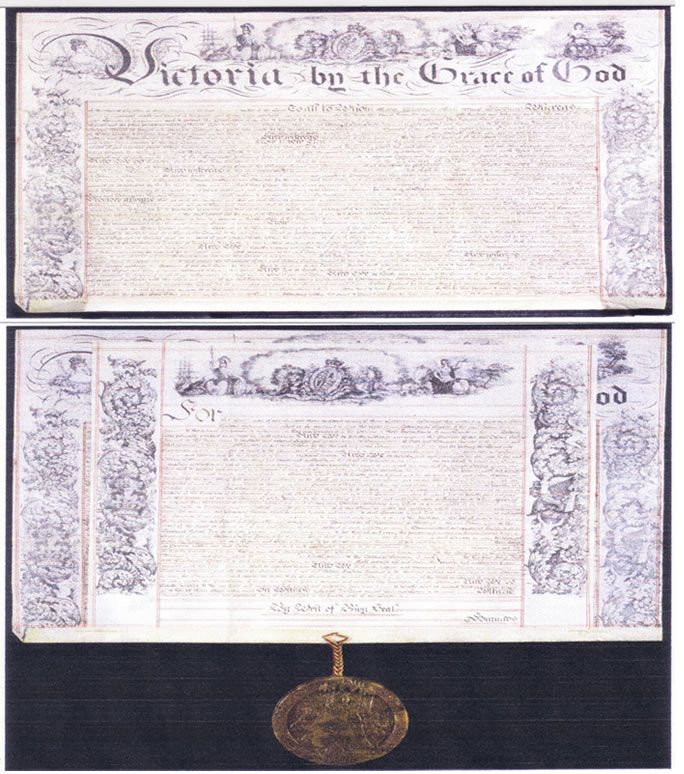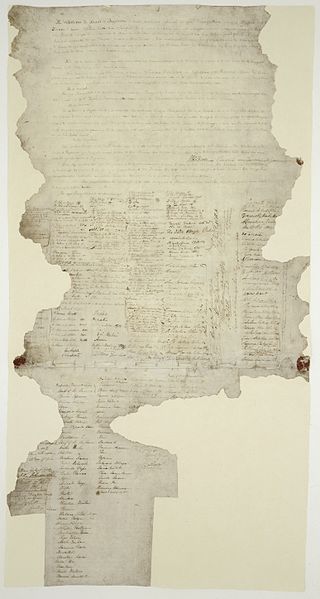The Tiriti o Waitangi played a very small role in New Zealand becoming a British Colony.
This document is Part 2 of; “Charter of 1839” by the One New Zealand Foundation Inc.
After researching the Charter of 1839 and the Royal Charter of 1840, both documents completely ignored by Government and our National Museum Te Papa, I found the Treaty of Waitangi only played a very small role in New Zealand becoming a British Colony. The discussions by the British Government to become involved in New Zealand had continued since 1831 when 13 Ngapuhi chiefs had asked the King to be their Guardian and Protector.
Both the Charter of 1839 and the Royal Charter of 1840 were beautifully prepared, presented and written documents in pristine condition, whereas the Tiriti o Waitangi was badly prepared, badly presented and very badly written for a document issued by Great Britain, but then it only played a small part to satisfy the “Clapton Sect”, a group of people that sought to protect “indigenous people from colonial exploitation”.
See, https://paperspast.natlib.govt.nz/newspapers/NZGWS18390906.2.7
Charter of 1839.
The 1839 Charter was a beautifully presented document issued by “Victoria by the Grace of God” that extended the boundaries of New South Wales to include “All the territories acquired in Sovereignty by Treaty within that group of Islands in the Pacific Ocean commonly called New Zealand”, under the laws and dependency of New South Wales.

The beautifully prepared, presented and written Charter of 1839 that extended the boundaries of New South Wales to include New Zealand.
Queen Victoria’s Royal Charter/Letters Patent
Queen Victoria’s Royal Charter/Letters Patent dated the 16 November 1840 was also a beautifully prepared, presented and written document issued by “Victoria by the Grace of God” that separated New Zealand from New South Wales on the 3 May 1841 and made New Zealand into a British Colony in its own right with political, legal and justice systems under one flag and one law, irrespective of race, colour or creed.

The beautifully prepared, presented and written Royal Charter of 1840.
Our true Founding Document and first Constitution ignored by government!
The Tiriti o Waitangi played a very small role in New Zealand becoming a British Colony.
 The Treaty of Waitangi was not issued by “Victoria by the Grace of God”. In fact, the Treaty of Waitangi was a very badly prepared, presented and written document on 2 pieces of dog-skin sewn together. A very primitive document when compared with the 1839 Charter and the 1840 Royal Charter. Once it had achieved it purpose of gaining sovereignty over all the islands of New Zealand on the 21 May 1840, it was filed away in a storage shed where it was later damaged by fire and rats.
The Treaty of Waitangi was not issued by “Victoria by the Grace of God”. In fact, the Treaty of Waitangi was a very badly prepared, presented and written document on 2 pieces of dog-skin sewn together. A very primitive document when compared with the 1839 Charter and the 1840 Royal Charter. Once it had achieved it purpose of gaining sovereignty over all the islands of New Zealand on the 21 May 1840, it was filed away in a storage shed where it was later damaged by fire and rats.
The Treaty’s main purpose was to satisfy the Clapton Sect who were a group of people that sought to protect indigenous people from colonial exploitation and were becoming a very strong group in England at the time. Amongst other British politicians, Sir James Stephens, Undersecretary to the Colonies was a member of the Clapton Sect. Sir James Stephens had drafted the, “Slavery Abolition Act of 1833”.
Instructions for a Treaty with the tangata maori was also drafted by Sir James Stephens, Undersecretary for the Colonies and was given to Captain William Hobson by Lord Normanby, Secretary of State for the Colonies, before Hobson sailed for New Zealand in 1839.
As the boundaries of New South Wales had been extended to, “All the territories acquired in Sovereignty by Treaty within that group of Islands in the Pacific Ocean commonly called New Zealand”, Captain Hobson was dispatched to New Zealand with Sir James Stephen’s instructions to acquire as many territories as possible from the tangata maori, “without force”.
The people that signed the Tiriti o Waitangi in 1840 were not tangata whenua or the indigenous people of New Zealand, they signed their names as “tangata maori”!
When Captain Hobson reached New South Wales he was sworn in as Lt. Governor to New Zealand under the command of Governor Gipps of New South Wales. Hobson then sailed to New Zealand and issued a Proclamation to the settlers on the 30 January 1840 that, “The boundaries of New South Wales had be extended to include, all the territories acquired in Sovereignty by Treaty”.
With the help of the British Resident to New Zealand, James Busby, Hobson drafted the Treaty of Waitangi. The treaty was based on the instructions drafted by Sir James Stephens, “To acquire as many territories without force and in return, tangata maori would be given the same rights as the people of England”, Tiriti o Waitangi, Article 3.
While Hobson’s final draft dated the 4th February 1840 was translated into the tangata maori language by Rev Henry Williams and his son Edward, then transcribed onto dog-skin by Rev Richard Taylor, it seems to have been a very low key document only to satisfy the Clapton Sect, a group of people who sought to protect indigenous people from colonial exploitation. It was the only document of its type ever issued by Britain that gave the inhabitants of a country, in this case the tangata maori, “The same rights as the people of England”. See Tiriti o Waitangi, Article 3.
After each chief had signed the Tiriti o Waitangi at Waitangi on the 6 February, Lt. William Hobson shook their hand and repeated, “He iwi tahi taou – We are now one people”. At the end of the Tiriti o Waitangi signing at Waitangi on the 6 February 1840, the whole gathering gave 3 hearty cheers.
When Lt. Governor Hobson became ill with a stroke and delegated the signing of the Tiriti o Waitangi to others, he gave these instructions, “The treaty which forms the base of all my proceedings was signed at Waitangi on the 6 February 1840, by 52 chiefs, 26 of whom were of the federation, and formed a majority of those who signed the Declaration of Independence. This instrument I consider to be de facto the treaty, and all signatures that are subsequently obtained are merely testimonials of adherence to the terms of that original document”.
Lt. Governor Hobson never made or authorized an English versions and no English version was signed on the 6 February 1840 at Waitangi. Although Hobson did have 200 copies of the Tiriti o Waitangi printed by the Church Mission Society of which one was read, discussed and signed at Waikato, although an unauthorized English version compiled by Hobson’s secretary, James Freeman from James Busby’s rough notes was used, but never read or discussed to hold further signatures when the CMS printed copy of the Tiriti o Waitangi could hold no more. Both copies were attached to each other when signed by Lt. Governor Hobson.
Conclusion.
Britain took little interest after Captain James Cook set foot on New Zealand shores in 1769 until the Rev Samuel Marsden in 1814 and other missionaries that joined him later, starting teaching Christianity to the tangata maori living in New Zealand. Again little happened until Rev Thomas Kendall invited Hongi Hika to England to help Professor Samuel Lees complete the tangata maori to English dictionary in 1818. Hongi Hika agreed to go with the ulterior motive of purchasing muskets while in England. While he was not allowed to take muskets out of England, he did a secret deal with Barron de Thierry and purchased over 500 muskets for 40,000 acres of land in New Zealand. He had de Thierry ship the muskets to Australia where Hongi Hika picked them up on the way back to New Zealand in 1820.
Hongi Hika with his Ngapuhi followers then went on a rampage south slaughtering thousands of his unarmed country men, women and children for utu/revenge or the fun of the fight and the feasts that followed. By 1831 Ngapuhi were afraid the southern tribes were now gathering musket and would in turn travel north for utu so 13 Ngapuhi chiefs wrote to the King of England asking him for protection and to be their guardian.
At the time Britain was having enough problems around the world and did not want to get involved in another country half a world away, but did decide to send a Resident, James Busby to New Zealand in 1833 to sort out the intertribal fighting and bring peace amongst the settlers and the tangata maori. As Busby had no forces at his deposal he was soon named the, “Man of war without guns”.
As the intertribal fighting increase with Waikato annihilating Taranaki in 1835 and the Taranaki that fled south traveling to the Chatham Islands, slaughtering and farming the unarmed Moriori men women and children like swine into virtual extinction and the settlers being threaten, killed and their farms ransacked by the “rebel tangata maori”, Britain had to take a more active role in protection its people, their farms and the law abiding tangata maori Britain had promised.
From 1937 Britain reluctantly discussed how it would become more involved in New Zealand and it was decided in 1839 to extend the boundaries of New South Wales to include all the islands of New Zealand. With the Clapton Sect becoming powerful in England at the time and the Undersecretary for the Colonies, Sir James Stephens being a member, it was decided in 1839 to, “To extend the boundaries of New South Wales and acquire as many territories in Sovereignty by Treaty within that group of Islands in the Pacific Ocean commonly called New Zealand”.
It was decided in 1839 by the Secretary of State, Lord Normanby to send Captain William Hobson to New Zealand with quickly drafted instructions for a treaty with the tangata maori by Sir James Stephens. Lt. Governor Hobson gained sovereignty over all the islands of New Zealand on the 21 May 1840, which was posted in the London Gazette on the 2 October 1840.
Once Britain had gained sovereignty over all the Island of New Zealand on the 21st May 1840 under the laws and dependency of New South Wales, it was decided some 4 months later by Queen Victoria’s Royal Charter dated the 16 November 1840 to separated New Zealand from New South Wales into an independent British Colony on the 3rd May 1840 with its own political, legal and justice systems under one flag and one law, irrespective of race, colour or creed.
While it took Britain years to decide on the best way to intervene in New Zealand, the Tiriti o Waitangi only took 3 days to draft and 4 months to gain sovereignty over all the islands of New Zealand, therefore, played a very small role in New Zealand becoming a British Colony, which would have happened eventually, with or without the Tiriti o Waitangi.
It may be the Tiriti o Waitangi was only a “courtesy or goodwill” agreement between Queen Victoria and tangata maori to satisfy the Clapton Sect as Britain had never had a treaty with any other country it had taken over but the Tiriti o Waitangi did give Britain sovereignty over all the islands of New Zealand which has never been disputed by any other country to this day!
In 1975 the New Zealand Government passed the 1975 Waitangi Tribunal Act that set up the Waitangi Tribunal by misleading the people that an unauthorized English version of the Treaty of Waitangi was our Founding Document and from this, wrote the “Five Principles for Crown Action on the Treaty of Waitangi”. This would be the most corrupt Act ever passed by a New Zealand government by deliberately ignoring the 1839 Charter and Queen Victoria’s Royal Charter/Letters Patent in our legislation. The Treaty of Waitangi is not our Founding Document!
All New Zealand’s important historical documents were held in the Constitution Room at Archive New Zealand, Wellington, but when the One New Zealand Foundation Inc. brought the 1840 Royal Charter to the attention of the public in 2015 the government spent $7.2 million setting up the He Tohu Exhibit at the National Library, Wellington in April 2017 to hold the Tiriti o Waitangi and dismantled the Constitution Room to separate our historical documents by filing Lt Governor Hobson’s final draft of the Treaty of Waitangi, the 1839 Charter and Queen Victoria’s 1840 Royal Charter with the other 6 million documents at Archive’s repository were they will soon be forgotten forever.
The Declaration of Independence was also moved to the National Library Wellington with the Tiriti o Waitangi. The Declaration of Independence was a failed attempt by Resident, James Busby to form a united government in New Zealand. The signatures to this declaration were to assemble annually to form laws for the promotion of peace, justice and trade, but the ever present inter-tribal tension and fighting took precedence over political co-operation, as always and it was abandon without one meeting taking place. Why would this failed attempt to get the chiefs to form a united government be put on display in the $7.2 million National Library He Tohu Exhibit when Busby could only get 52 chiefs to sign it? The only document that was also moved to the National Library that fits this new location was the “1893 Women’s Suffrage Petition”.
There is only one true Foundation Document and first Constitution and that is the beautifully prepared, presented and written Royal Charter/Letters Patent dated the 16 November 1840 that was issued under, “Victoria by the Grace of God”, and we must all be extremely proud of this document by displaying it in all government building, schools and our National museums.
We must also celebrate the day it was enacted, the 3rd of May and honour the sacrifices our ancestors, both tangata maori and the settlers made to bring peace to a country completely out of control!
While all this information can be found in Archives around the world, the government, Te Papa and our historians have completely ignore it, until the One New Zealand Foundation Inc. brought the Charter of 1840 and the Royal Charter of 1840 to the public’s attention. These vital documents had never been included as part of our history or legislation. This must end now, they are a vital part of our true history and legislation and must no longer be ignored to satisfy one small group of New Zealand citizens that can claim a minute trace of tangata maori ancestry.
These documents completely change the true history of New Zealand and honour the true meaning of the agreement Lt. Governor Hobson made with the tangata maori chiefs at Waitangi on the 6 February 1840 with a handshake and the words;
“He iwi tahi tatou – We are now one people” – New Zealanders.
This document is Part 2 of; “Charter of 1839” by the One New Zealand Foundation Inc.
By Ross Baker, Researcher, One New Zealand Foundation Inc. Email: ONZF@bigpond.com.au (C). 20/5/2017.